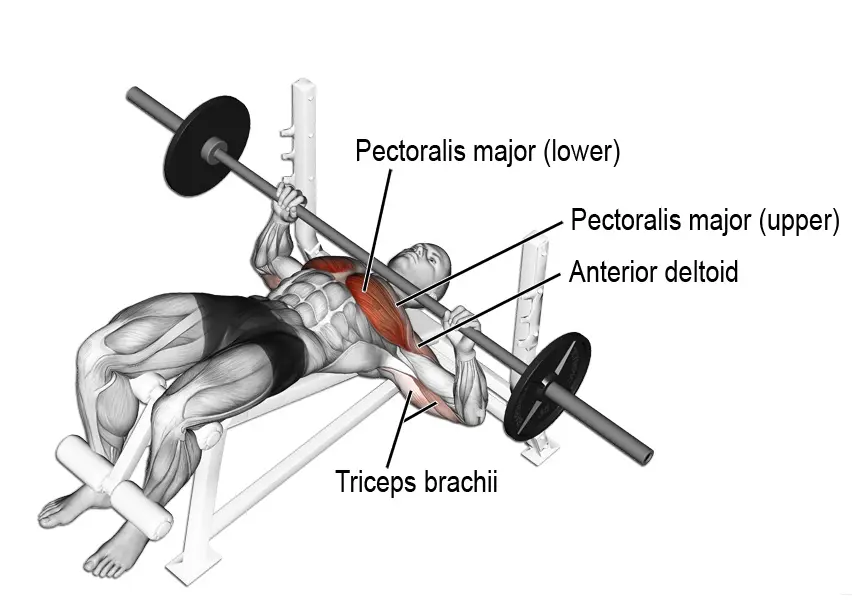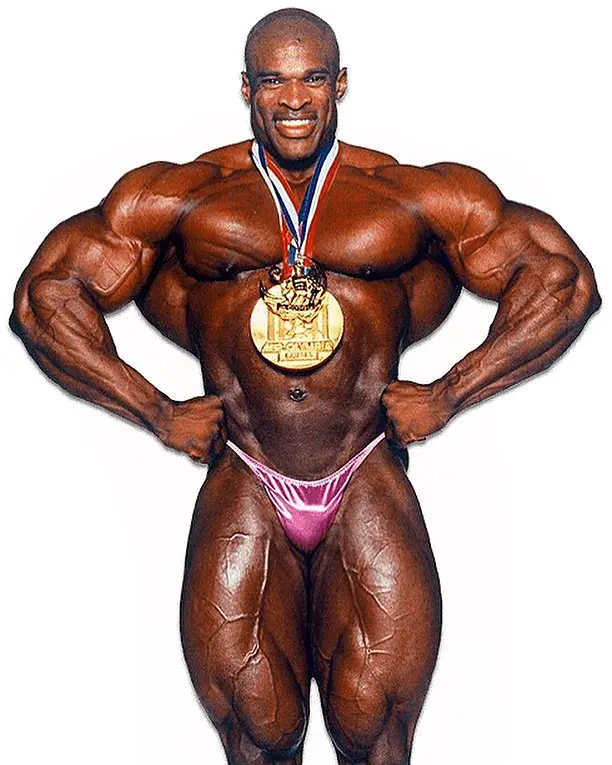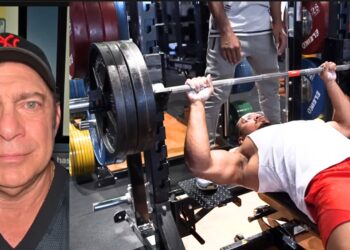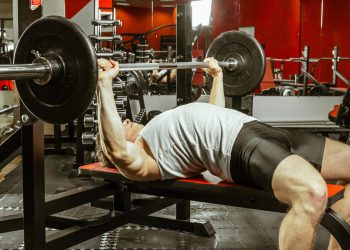The decline bench press isn’t exactly an exercise that gym bros are lining up for on National Chest Day… ahem… every Monday.
But does that mean this variation is useless just because it doesn’t get as much attention as the much-beloved flat and incline bench press? Not one bit.
Although, it may not be necessary for everyone to incorporate it into their chest training regime, but that’s why we’ve devised a guide detailing as much about this variation as you’ll need to know.
What Is The Decline Bench Press?
So you’d think everyone would know what the setup looks like for this exercise. But for the individual new to training, this may not be the case.
The decline bench press is simply a variation of the barbell bench press with the bench positioned at a declined angle so that when you lie on it, your head is the closest part of your body to the ground.
And it’s primary use is for targeting the lower pectoral (chest) muscles near the sternum.
Level Up Your Fitness: Join our 💪 strong community in Fitness Volt Newsletter. Get daily inspiration, expert-backed workouts, nutrition tips, the latest in strength sports, and the support you need to reach your goals. Subscribe for free!

How To Do The Decline Bench Press Correctly
There are always a few different variables that will determine exactly how each individual performs any given exercise. But for a bench press variation, there are a few form tips that everyone should adhere to for not only effectively executing the movement but to also ensure you remain injury-free.
Note: The angle at which this exercise is performed can result in lightheadedness especially upon standing after a set due to the lack of normal blood circulation. You have to be the best judge of how you feel but we do highly recommend enlisting the help of someone to assist you during the movement for your overall safety. The decline bench press is also a little different than the flat and incline press because the weight can shift backward and down if you’re not accustomed to regularly doing this exercise.
So, take all necessary safety precautions and we always advise making your doctor/medical professional aware of your decision to engage in a fitness regime.
Ok, now we can take you to the step-by-step instructions.
Do the barbell variation only if you have access to a decline bench with a rack and leg support attachment to keep you secured in place. Otherwise, dumbbells are the safer option for a simple decline bench setup. Although, we still wouldn’t recommend going to heavy without a full setup.
Step 1: Lie supine on the bench with your ankles secured under the foam supports.
Step 2: Grip the barbell wider than shoulder-width but not too wide (bad for the shoulders and pecs) and move your body into a comfortable position using the bar as your guide.
The bar should be around mid-chest level to effectively unrack it.
Step 3: Tuck your arms slightly so each is at about a 45-degree angle to your torso. Then retract your shoulder blades, flex your lats, and straighten your wrists.
Step 4: Unrack the barbell by sliding it off the pegs using your lats and move it forward so that it’s above your sternum area with arms straight up. This is best for hitting the lower pecs and it’ll also prevent you from hitting the pegs.
Step 5: Lower the bar all the way down while inhaling and then press it straight up while exhaling and contracting your chest muscles.
Make sure to keep everything tight and don’t overpress which will result in too much shoulder protraction. Also, choose a spot on the ceiling to press toward to avoid using too much of your deltoids rather than the chest muscles.
Decline Bench Press Benefits
Muscle growth
The obvious benefit of this variation is that it emphasizes the lower chest muscles, stimulating more fibers in this area. Although, it still works the entire chest area and front deltoids to a similar degree where hypertrophy is concerned when compared to the flat bench, according to research. (1)
One 1997 study published in The Journal of Strength and Conditioning Research set out to determine the motor unit recruitment relationship in different areas of the pectoralis major by performing two different bench press exercise. (2)
Fifteen young, experienced male volunteers performed 6 reps of the incline and decline bench press (+30 and −15° from horizontal, respectively) with electrodes placed on areas of the upper and lower chest where typical muscle activity occurs.

Drumroll please… the decline bench press showed significant activation of the lower chest during both the concentric (positive) and eccentric (negative) portions of a repetition, while there was no notable difference in activation of the upper chest between both the incline and decline bench press.
So, it was concluded that the lower chest can be targeted more specifically with regard to the exercise angle, whereas the incline variation showed no changes to the upper chest.
Now, of course, with many studies, there are different variables to be considered and research has also shown upper chest activation at certain time points during an inclined angle. But in this study, the subjects were experienced in weight training which gives us some credible evidence. (3)
The decline bench press also works the triceps pretty thoroughly since this muscle is a big assister for pushing that bar up through elbow extension and controlling the negatives.
Increased strength
Being a compound, multi-joint movement, you’re going to increase strength in all of the muscles involved if you’re regularly implementing progressive overload.
This can be achieved through any of the main variations although the barbell variation is best for gaining maximum strength.
Less stress on back and shoulders
Due to the decline angle, the decline bench press shifts the weight load to your lower pectoral region, therefore alleviating some of the back and shoulder stress common with the flat and incline positions.
Therefore, you can train relatively heavy with this movement and know that most of the focus is going to be on the lower pecs.
How To Implement The Decline Bench Press
Let’s put it this way… if the decline bench can offer something that the other two variations do (which it does according to research), then it would be wise for everyone to incorporate it into their training if they can do it safely and effectively.
However, don’t let it take away from your other pressing movements since you should ideally train using various angles with different variations for optimal chest development.
But also, strength athletes who have to perform on the flat bench press will want to limit the time spent on this variation because their performance depends on being proficient in the basic bench press.
Although, for hypertrophic purposes, some inclusion of the decline variation can clearly help to improve your chest development.
For the people just looking to maximize hypertrophy and aesthetics though, while also improving strength, of course, do your incline and flat press but include 3-4 sets of decline as well.
Level Up Your Fitness: Join our 💪 strong community in Fitness Volt Newsletter. Get daily inspiration, expert-backed workouts, nutrition tips, the latest in strength sports, and the support you need to reach your goals. Subscribe for free!
And like we mentioned previously, there is the element of potentially getting lightheaded due to the decline angle and it’s simply not realistic or safe for everyone. But… this is where variations and other exercises for the lower pecs are extremely valuable because some don’t require you to be in a declined position.
Decline Barbell Bench Variations
The decline barbell bench press is always going to be king just because it allows you to use the most weight to target the lower pecs.
But that doesn’t mean it’s the only way to stimulate growth and increase strength.
Here are some variations…
Decline dumbbell bench press
Dumbbells are right up there with the barbell for most effective training tools.
The decline dumbbell bench press allows you to get a really strong contraction and stretch in a muscle due to having a freer range of motion (you can also use a neutral grip for an even better contraction), not to mention the stabilization required is very beneficial as well.
And if you have an imbalance, the dumbbells can help with that too by exposing any weaknesses on either side.
But if you choose to go this route every now and then or if you only do dumbbells for the decline press, then there are a few things to keep in mind…
Like mentioned earlier, if you don’t have access to a decline bench setup with an attachment to secure your feet, then opt for the lighter-moderate dumbbells as it will be very difficult and possibly dangerous to try and get into position due to the angle of the bench.
But even if you do have access to an entire decline bench setup and want to train using heavy dumbbells, then we recommend having someone hand you the dumbbells in the upright starting position because due to the height of the foot end of the bench, it will be very difficult to do by yourself.
Although, if you’re more advanced in your training then you’re likely aware of this.
Decline cable press
Cables are another amazing tool that keeps constant tension on a muscle but it also allows for a relatively free range of motion. So, it’s always a good idea to add in more cable work to continue progressing.
You’ll basically set up a decline bench between the two close-positioned cable pulleys to do the press using the same form as the free weight variations. But, you won’t be able to use maximum poundages here as you’ll have less stability and it could be dangerous.
You can use single grips or even attach a straight bar to the cables to more closely mimic the barbell press.
Here are a few video examples…
Floor press w/ hip bridge
This is a viable option for those who do not have access to a decline bench. You’ll utilize the hip bridge to create the decline position but for this exercise, we recommend training with light to moderate weights for beginners and more advanced lifters can set up inside of a rack and utilize heavier barbell pressing.
Here are a couple of examples…
Decline machine press
The Smith machine and other types of machines can be used to perform the decline press; which makes for very effective variations.
Other Lower Chest Exercises
Chest or Gironda dip
The dip is one of the best bodyweight exercises available for building the chest and triceps. But the angle at which you perform this movement will determine where more of the focus is directed.
To better target the chest, you’ll want to lean forward into the dip rather than maintaining an upright position. This will shift the emphasis onto the lower pecs, although it’s impossible to take the triceps out of the movement.
Use a Captain’s Chair or dipping bars for this exercise.
Incline push-up
By doing push-ups with your upper body elevated, you can simulate the decline press. And quite possibly the best thing about this exercise is that you don’t need weights. Just a bench or any surface raised high enough off the ground.
Also, check out these 13 next-level push-up variations.
Low cable fly
The low cable fly performed from low to high is an excellent lower pec builder. You’ll basically set the cable handles at a low point then bring both arms up and together to lower chest level.
You should feel an amazing contraction in your lower chest.
Decline cable fly
The decline cable fly is a safer choice over using dumbbells because the movement is a bit more controlled and you still benefit from the constant tension on the muscle.
For this one, you can place your bench between a wider cable pulley setup but you should still maintain proper form to ensure you don’t injure a pec.
The fly is an exercise that many people tend to steer away from due to the compromising position it places the chest and even shoulders in if done incorrectly.
But you want to make sure to not use maximum poundages for this movement and keep your arms bent for optimal protection during the exercise.
Wrapping Up
The decline bench press is an exercise that can absolutely be beneficial for your training and physique progress.
There’s evidence to suggest that it’s good for targeting more of the lower pec fibers which means including it in your routine could be a very good move on your end.
We shared some variations and other exercises as well so hopefully, you’ll put this information to use in the form of an effective chest workout.
Also read:10 Bodybuilders With The Most Ridiculous Pectorals In Bodybuilding History!








